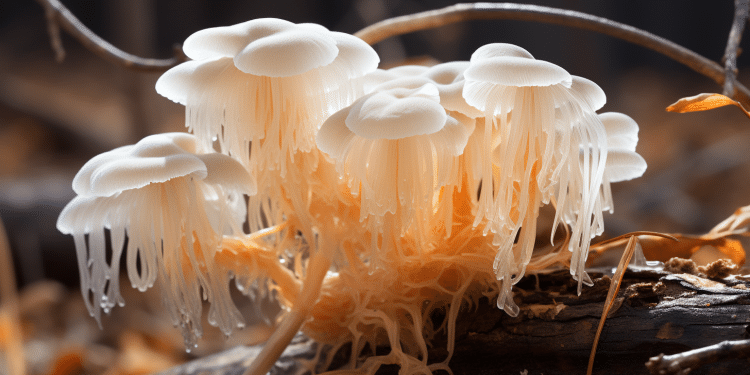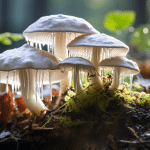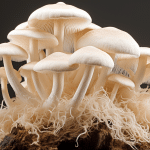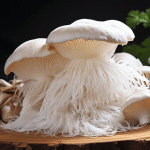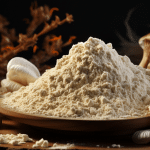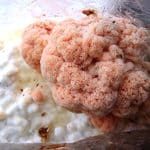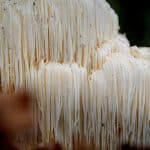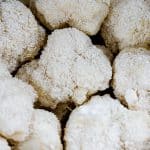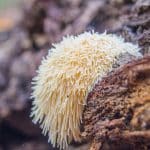Are there Any Toxic Lion’s Mane Mushroom Look-Alikes?
Lion’s mane mushrooms do not have any toxic look-alikes, according to the Minnesota Department of Natural Resources. This is the biggest reason why these mushrooms are an excellent choice for beginning foragers: They are very easy to identify. That said, there are some other edible mushrooms you might mistake for lion’s mane if you are just starting out, so we wanted to talk about a couple lion’s mane mushroom look alikes.
Lion’s Mane Look-Alikes Bears Head Tooth (Hericium Americanum)
This is a species that is quite close to true lions mane, and, indeed, is considered to be the same species by many mushroom hunters. The main difference is that rather than having a single, snowball-like structure, the Bears Head Tooth has many shorter branches tightly clustered together.
You will find this mushroom growing on dead logs during late summer and fall. It may also be found growing on wounds of dying or dead trees. Hericium americanum grows most often in hardwoods, though sometimes on conifers.
Bears-head-tooth is a tasty edible mushroom, though due to its shape and the way that it grows, it is often messy and hard to clean. That is, if you do find one covered with mud, you can just rinse it in cold water to remove any muck before cooking. Some people claim the taste is slightly fishy, but from my experience with any Hericium species, it actually tends to simply pick up the flavors of whatever it is cooked in.
The closest thing to looking like lions mane is a bears head tooth mushroom which you can see here:

The bears head is a member of the same family as the lion’s mane, producing swarthy, white fruiting bodies that closely resemble the lion’s mane mushrooms spines. The main difference between these two types of mushrooms is that the lions mane is rounder and bulbous, while the bears head is more branchy.
Another key difference is that bears heads tend to grow on evergreens, particularly Douglas fir. Lion’s mane are most often found on dead or rotting deciduous hardwoods, like oaks and maples.
Bears-head mushrooms are often described as having a nutty, earthy flavor, with slight seafood notes. Lion’s mane mushrooms have a slightly stronger taste and odor. Despite their similarity to the bears head tooth mushroom, lion’s mane mushrooms are distinct and unique, easy to tell apart by anyone with some foraging experience. Hunters of lion’s mane mushrooms only have to recognize this curiously unique mushroom for its shaggy mane, or its teeth that look like icicles, its fishy smell, and its deciduous hardwood habitat.
Coral Tooth Fungus (Hericium Coralloides) is Another Look-Alike
Although it is still within the Hericium genus, it certainly looks significantly different than Bears-Head-Tooth and True Lions Mane. Instead of teeth growing out from one center spot, H. corraloides grows a wide array of irregularly-shaped branches of different lengths. The spines coming out of the branches are, however, long and thin, extending down to the ground.
Hericium corraloides is, in my experience, more abundant than any other species of Hericium, so this is a good species to be aware of. Also, if you do find a fruit, you have got a very good chance of finding many others, so make sure you are looking around. I often find multiple log fruits of this mushroom in the immediate vicinity.
How Do You Identify A Lion’s Mane Mushroom? What Does It Look Like?
Here’s a video that provides further detail into identifying lion’s mane:
Lions Mane Mushrooms possess a few distinctive features. The first and most obvious is the lions mane-like, white, fuzzy appearance.
These globular, shamrock-shaped mushrooms are found growing in the dead or rotting hardwood trees during summer and fall. They will often grow a few feet above ground at the sides of these trees. These mushrooms may also be found in wounds of living trees as well as trees slowly dying.
They tend to re-grow from the same areas over the years, although they can grow in different places in the same tree. Sometimes, you can even find them growing in dead logs.
You can find our favorite capsules, powders, and tincture’s on the following pages of our website and learn more about each individually:
Our Favorite Lion’s Mane Supplements
Our Favorite Lion’s Mane Powders
Our Favorite Lion’s Mane Tinctures
Our Favorite Lion’s Mane Gummies
Lion’s mane can be found all over the northern hemisphere, growing in temperate forests and woodlands. These mushrooms are easily identified by their fuzzy appearance and their native habitat, but you can also tell by the scent. They smell relatively bland when compared to many mushrooms, but there is a distinct undercurrent of seafood in their scent.
Each spine, or tooth, is relatively short when the mushroom is young, but they can grow up to two inches long. A mature lion’s mane mushroom is composed mostly of these manes, opening one exposes a relatively small, bulbous, tiny body. When fully grown and uncorrupted, each of these mushrooms can grow to nearly the size of a dinner plate.
This mushrooms mane, while usually white, may have yellowish to pinkish hues; indeed, some begin pinkish, then eventually turn white. And when the mushroom has “lost its roar” and is past its prime, it will become completely yellow, eventually turning fading to an off-color orange. If you are a mushroom foraging novice, the lion’s mane is a great mushroom to begin with, as it is highly distinctive and easily identified. Of course, if you have not seen one before, watching an identification video such as the one above can be helpful in getting a strong visual on how it looks.
What Does A Lion’s Mane Mushroom Smell Like?
Lion’s mane mushroom has a relatively mild flavor, with no consensus as to what it really smells like. Some people report that the supplements smell bitter, like a bitter chocolate scent. This is an indication of high extraction ratios, the higher concentrations of powdered mushrooms, the greater chocolate-like smell and flavorings. However, lion’s mane harvested from the wild will rarely exhibit such a chocolate-like aroma.
Most foragers agree that when fresh from the wild, the mushrooms carry a slight fishy smell, suggesting crab cakes or lobster. Lion’s mane mushrooms are easily found in the wild, and they can even be grown at home, making this nutritious and medicinally-dense member of the mushroom family easily accessible and consumable. These mushrooms are noted for their ability to protect against dementia, anxiety, and depression, their soothing effects on neural damage, and their anti-inflammatory, antioxidant, and immune-boosting properties.
And did we mention that they are delicious. Maybe it is time for you to go for a walk in the dead tree forest, or consider growing a few of these tasty, nutritious mushrooms at home.
Additional Resources:
The Best Lion’s Mane Mushroom Grow Kit
Updated 10/11/2022
